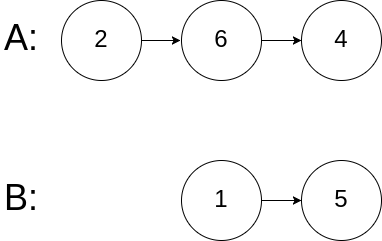Description
Write a program to find the node at which the intersection of two singly linked lists begins.
For example, the following two linked lists:

Example 1:

1
2
3
Input: intersectVal = 8, listA = [4,1,8,4,5], listB = [5,0,1,8,4,5], skipA = 2, skipB = 3
Output: Reference of the node with value = 8
Input Explanation: The intersected node's value is 8 (note that this must not be 0 if the two lists intersect). From the head of A, it reads as [4,1,8,4,5]. From the head of B, it reads as [5,0,1,8,4,5]. There are 2 nodes before the intersected node in A; There are 3 nodes before the intersected node in B.

Example 2:

1
2
3
Input: intersectVal = 2, listA = [0,9,1,2,4], listB = [3,2,4], skipA = 3, skipB = 1
Output: Reference of the node with value = 2
Input Explanation: The intersected node's value is 2 (note that this must not be 0 if the two lists intersect). From the head of A, it reads as [0,9,1,2,4]. From the head of B, it reads as [3,2,4]. There are 3 nodes before the intersected node in A; There are 1 node before the intersected node in B.
Example 3:

1
2
3
Input: head = [1], pos = -1
Output: false
Explanation: There is no cycle in the linked list.
Example 4:

1
2
3
4
Input: intersectVal = 0, listA = [2,6,4], listB = [1,5], skipA = 3, skipB = 2
Output: null
Input Explanation: From the head of A, it reads as [2,6,4]. From the head of B, it reads as [1,5]. Since the two lists do not intersect, intersectVal must be 0, while skipA and skipB can be arbitrary values.
Explanation: The two lists do not intersect, so return null.
Notes:
- If the two linked lists have no intersection at all, return null.
- The linked lists must retain their original structure after the function returns.
- You may assume there are no cycles anywhere in the entire linked structure.
- Your code should preferably run in O(n) time and use only O(1) memory.
Approach 1
Analysis: Brute Force way
Iterate the first linked list A, for each iteration, iterating the second linked list B thoroughly, compare if there is a intersection.
Time complexity O(MN) where M, N is the A’s and B’s length respectively.
This might cause time error for large linked list. Let’s consider a better way by reducing the time complexity to O(M + N).
Approach 2
Iterating the first linked list A and store every node into a Set object setA, then go through the second linked list B, and check if any node is within setA.
1
2
3
4
5
6
7
8
9
10
11
12
13
14
15
16
17
# Definition for singly-linked list.
# class ListNode:
# def __init__(self, x):
# self.val = x
# self.next = None
class Solution:
def getIntersectionNode(self, headA: ListNode, headB: ListNode) -> ListNode:
headA_set = set()
while headA:
headA_set.add(headA)
headA = headA.next
while headB:
if headB in headA_set:
return headB
headB = headB.next
return None
This solution could already beat around 80% online submissions on Leetcode.
Next, let’s think about Two Pointers way.
Approach 3
Suppose linked list A and linked list B intersects at node x, and the identical list before that is M and N respectively, the shared part (excluding node x)after is O, like this:
A: M + x + O
B: N + x + O
If we would like to reach the intersection node x at same time for both lists, it is a great idea to append the list to the end of the other, leading to:
A: M + x + O + N + x + O
B: N + x + O + M + x + O
Then if we iterate those two new lists, we should be able to reach the intersection node x at the same time, because they share (M + x + O + N) part at the beginning.
See implementation below:
1
2
3
4
5
6
7
8
9
10
11
12
13
14
class Solution:
def getIntersectionNode(self, headA: ListNode, headB: ListNode) -> ListNode:
a = headA
b = headB
while a != b:
if a:
a = a.next
else:
a = headB
if b:
b = b.next
else:
b = headA
return a
What if two linked lists don’t intersect at all? Like this:
A: M
B: N
Appending the list to the end of the other would still work? Let’s see:
A: M + N
B: N + M
A and B will have same length and can be iterated through within same time, both last element.next point to None, making the function returns None which is expected for this non-intersecting situation.
Beats 91% submissions. Time complexity of O(M + N), where M and N is the list’s length respectively.